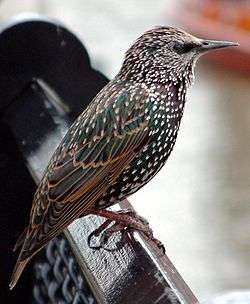Mozart's starling
For about three years the composer Wolfgang Amadeus Mozart kept a pet starling. The first record of the starling is the entry Mozart made in his expense book when he bought it on 27 May 1784:
- starling bird. 34 kreutzer.
- That was fine! [1]
The music Mozart jotted down in the book is fairly close to the opening theme of the third movement of his Piano Concerto No. 17 in G, K. 453, which Mozart had completed a few weeks earlier (12 April).[2] Mozart presumably taught the bird to sing this tune in the pet store, or wherever it was that he bought it. According to Mozart's transcription, the starling incorrectly inserted a fermata on the last beat of the first full measure, and sang G-sharp instead of G in the following measure.
Mozart probably was not joking when he made the transcription, because starlings are known to have a very strong capacity for vocal mimicry.[3]
The bird Mozart brought home lived as a pet in his household for three years and died on 4 June 1787. Mozart buried the creature in the back yard and wrote a commemorative poem for the occasion. Deutsch 1965 calls the poem "serio-comic". However, West and King note, based on their extensive experience, that starling pets interact closely with their human keepers, often causing their owners to bond with them. Thus, Mozart's expression of sorrow may have been quite sincere.

Notes
- ↑ Original German: "Vogel Stahrl 34 Kr. ... Das war schön!". "Schön" is most often translated as "beautiful"; the rendition quoted here is from Deutsch 1965. Another translator gives "That was wonderful!".
- ↑ The date of premiere is unknown. Mozart's student Barbara Ployer performed the concerto on June 13, but this may not have been the premiere; indeed it seems unlikely that Mozart would have waited for over two months to have the concerto performed. His concert with Regina Strinasacchi on 29 April 1784 at the Kärntnertortheater could have been an opportunity to play it for the first time. For discussion see Lorenz (2006, 314).
- ↑ See West and King (1990) and (in this encyclopedia) the article starling
References
- Deutsch, Otto Erich (1965) Mozart: A Documentary Biography. Stanford, CA: Stanford University Press.
- Lorenz, Michael (2006) "New And Old Documents Concerning Mozart's Pupils Barbara Ployer And Josepha Auernhammer", Eighteenth-Century Music 3/2, (Cambridge University Press).
- West, Meredith J. and Andrew King (1990) "Mozart's Starling". American Scientist, March-April issue. Discussion in depth from an ornithological point of view, as well as the text of Mozart's obituary poem. Posted on the Internet: .